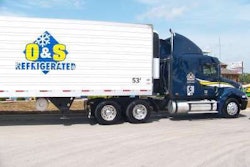Collision warning systems offer immediate feedback
Ryder System’s Bob Prim has seen even the best and most experienced drivers get into trouble. “Often, a driver with a great safety record can still get into trouble because a good driver operates without a lot of feedback,” says Prim, the company’s director of safety standards. The driver may have one bad habit, or something in his life that is affecting him. “If we don’t know much about any bad habits he’s developing, we can’t offer feedback to help him eliminate the problem,” he says.
That’s why Ryder uses a driver improvement system called GreenRoads, which includes in-vehicle hardware and software designed to continuously measure forces on a vehicle as it is driven. Sensors analyze up to 120 separate types of driving events in five categories: speed handling, cornering, lane handling, braking and acceleration. Patented algorithms associate risk with vehicle movement and categories of driving, and automatically assess driver safety, says Eric Weiss, senior vice president of worldwide marketing.
GreenRoads provides feedback to the driver with green, yellow and red lights. If a driver enters a turn at excessive speed or turns too sharply, he may get a blinking yellow light; if the behavior continues, he’ll get a solid yellow light. If he were to brake hard, the light would blink red and then return to the prior status. The system keeps track of overall performance and reports information to fleet managers over the company’s website, Weiss says.
The Vorad VS-400 with SmartCruise, now marketed by Bendix, has a radar sensor that sends a signal 500 feet ahead of the vehicle, says Fred Andersky, director of marketing for the system. Vorad computes a safe following distance based on the truck’s speed and the rate at which it may be closing on the vehicle ahead. The system tracks a forward vehicle and helps the driver maintain a safe following distance behind the vehicle through alerts and active intervention. “The driver gets lights and beeps that ramp up with an increase in potential danger,” Andersky says.
When the cruise control is engaged and the truck approaches a slower vehicle too closely, the system will intervene to help slow the vehicle and maintain a set following distance through throttle reduction and engaging the engine retarder, he says. A more advanced system, Bendix Wingman ACB, also will apply the foundation brakes to maintain an appropriate speed and following distance.
Iteris Inc.’s flagship product is Lane Departure Warning, which uses what’s called “machine vision” technology to track lane markings, says Bill Patriola, the company’s director of North American truck sales. LDW provides a “rumble strip” audible warning whenever a vehicle leaves a lane unintentionally, meaning without the use of a turn signal. Warnings are directional and correspond to the direction of travel.
The forward collision warning system provides headway alerts and warnings when a vehicle is following too closely. “There are a couple of different types of beeps depending on the following distance,” Patriola says.
LDW is designed to prevent sideswipes, inadvertent lane changes and run-off-the-road accidents. “We have data collected from five separate fleets totaling 1.2 billion miles,” Patriola says. “The rate of these types of accidents is 75 percent lower during the same time period than on trucks not equipped.”
Safety Vision’s collision avoidance systems feature rear-, side- and forward-view cameras, in-cab monitors and mobile digital video recorders. The SV-CLCD-70 supports four cameras with switchable camera views to provide the most comprehensive coverage of the vehicle, says Bruce Smith, the company’s president and chief executive officer. The system is simple to install and maintain, and turns on and off with the ignition, Smith says.
The surveillance system’s camera, the SV-622, has a built-in microphone designed to allow people behind the vehicle to communicate directly with the driver and alert him to possible hazards, he says. “With the camera system, the driver will be able to see behind and around the vehicle to be aware of blind spots or anything that could get in the way of the vehicle while maneuvering.”
Each sensor on TailGauge Inc.’s system emits ultrasonic waves and senses those waves when they bounce off an object – similar to radar, but more accurate for on-the-road applications, says Fred Jacobowitz, customer information representative. The sensors send the data to a CPU – usually located under the truck – that analyzes and interprets the data, and alerts the driver.
All TailGauge systems are designed with an audible alarm in the form of a human voice and a beeper that speeds up and gets more insistent as the vehicle nears the obstacle. As the system continuously updates the information, the voice recording tells the driver how many feet are between him and the obstacle until the vehicle is about 18 inches from it, at which time “the alarm goes bonkers and the voice says ‘Crash!’ ” Jacobowitz says.
TailGauge originally was designed to prevent only rear-end collisions, including above the rear of the vehicle, but it also can be used to warn of side collisions and even front fender-benders if the buyer desires, he says.
Considering the difficulty of seeing around a tractor-trailer, and the difficulty of knowing the safety limits of a large vehicle under various driving conditions, using collision warning technology might be a cost-effective way to eliminate many types of crashes.













